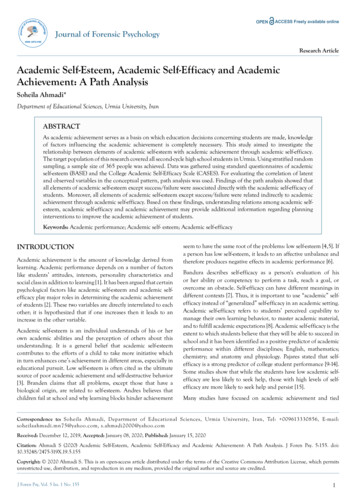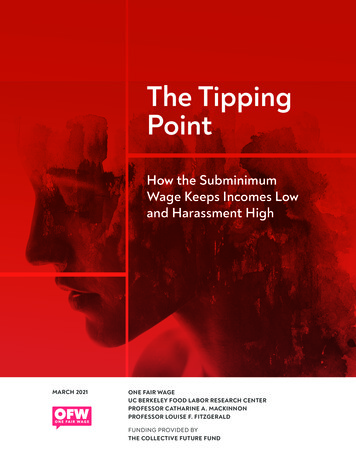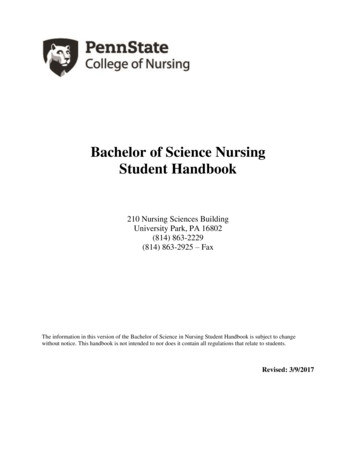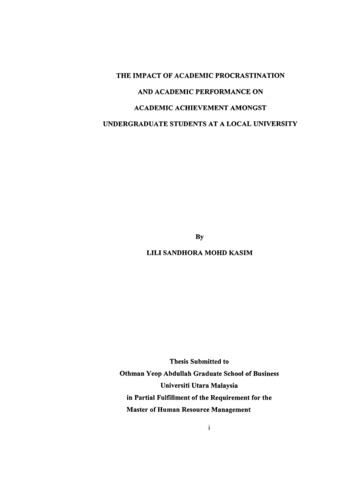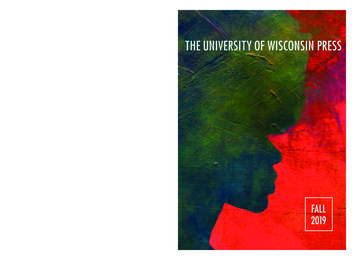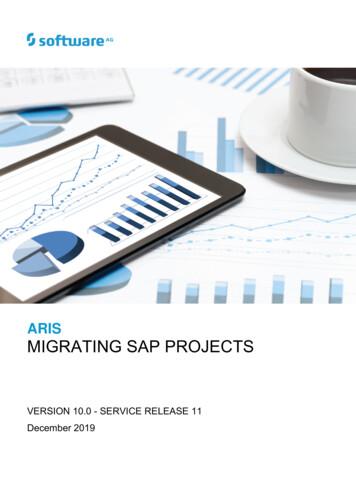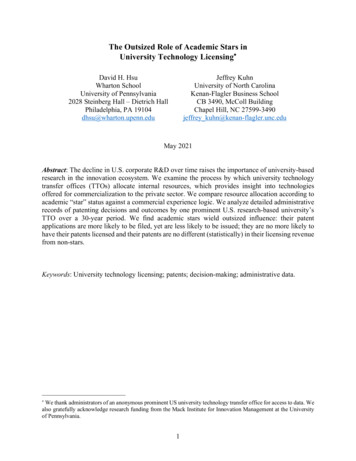
Transcription
The Outsized Role of Academic Stars inUniversity Technology Licensing*David H. HsuWharton SchoolUniversity of Pennsylvania2028 Steinberg Hall – Dietrich HallPhiladelphia, PA 19104dhsu@wharton.upenn.eduJeffrey KuhnUniversity of North CarolinaKenan-Flagler Business SchoolCB 3490, McColl BuildingChapel Hill, NC 27599-3490jeffrey kuhn@kenan-flagler.unc.eduMay 2021Abstract: The decline in U.S. corporate R&D over time raises the importance of university-basedresearch in the innovation ecosystem. We examine the process by which university technologytransfer offices (TTOs) allocate internal resources, which provides insight into technologiesoffered for commercialization to the private sector. We compare resource allocation according toacademic “star” status against a commercial experience logic. We analyze detailed administrativerecords of patenting decisions and outcomes by one prominent U.S. research-based university’sTTO over a 30-year period. We find academic stars wield outsized influence: their patentapplications are more likely to be filed, yet are less likely to be issued; they are no more likely tohave their patents licensed and their patents are no different (statistically) in their licensing revenuefrom non-stars.Keywords: University technology licensing; patents; decision-making; administrative data.*We thank administrators of an anonymous prominent US university technology transfer office for access to data. Wealso gratefully acknowledge research funding from the Mack Institute for Innovation Management at the Universityof Pennsylvania.1
1. INTRODUCTIONUniversities are an important part of the entrepreneurship and innovation ecosystem, both intheir training and research activities (e.g., Nelson, 1993; Furman, Porter & Stern, 2002). Theknowledge they generate is also directly and indirectly important for industrial managers in theirproduct and service development (e.g., Mansfield, 1991; Cohen, et al. 2002; Foray & Lissoni,2010; Cohen, 2010). The reliance on university science, often federally funded (Fleming et al.2019), is likely exacerbated by the secular decline in research (as opposed to development) effortsin U.S. corporations over the past 40 years (Arora, Belenzon & Patacconi, 2018).While academia-industry knowledge linkages can occur in various ways, technology licensingand commercialization efforts are particularly important. In 2018 alone, over 17,000 patentapplications were filed, over 7,600 patents were granted, 828 new products were created, and over1,000 start-ups were formed (as reported by the Association of University Technology Managers).Moreover, some studies have suggested that universities are disproportionately responsible forbreakthrough commercial technologies (Colyvas, et al. 2002). Nevertheless, scholars typicallytreat university technologies as exogenous (e.g., Nerkar and Shane, 2007). Since universitymissions increasingly include economic development and commercial translation (e.g., Sanberg,et al. 2013), treating such technologies as given unfortunately obscures organizational resourcedecision-making underpinning the commercialization process. An important exception is recentwork by Cohen, Sauermann, and Stephan (2020), who examine how scientists’ motives to engagein commercial activity vary across technological fields.In this study we focus on the technology transfer office (TTO) managers who must makejudgements on allocating resources to pursue patent application filings on inventions disclosed byintellectual property (IP) producers (i.e., academic scientists and engineers). Patent protection is2
often a prerequisite to attracting potential technology licensees, which is a necessary step tocommercialization success (and associated licensing revenues). The patenting process is costly,however, and also entails foregone opportunity costs of other activities which could also help fulfillthe TTO’s mission.1 The large majority of patents are issued only after being initially rejected andamended, often many times, a potentially expensive process known as “patent prosecution.”Accordingly, TTO managers must decide not only whether to file a patent application, but alsowhether to continue to invest resources in its prosecution and post-grant renewal.To better understand university technology commercialization, we examine the resourceallocation decisions of one TTO which we term “PRU” (prominent research university) over a 30year time period. This new dataset includes both patenting decisions and commercial outcomes(including, importantly, those not yielding commercial value). We examine two logics underwhich TTO mangers may be making their decisions to engage in patent prosecution andtechnology commercialization given the typically uncertain and embryonic nature of thetechnology: IP producers’ (1) scientific and academic eminence (the traditional currency of meritin research universities) and (2) prior commercialization experience. Given the dearth of priorwork, we refrain from forming specific hypotheses, but end the paper with implications anddirections for future research.We find that both commercialization experience and academic prominence predict patentapplication filing, but only past commercialization experience predicts future commercializationsuccess. Academic prominence is nevertheless a strong predictor of renewal fee payment for1Most university TTOs seek to promote both the public good and private value. For example, the MIT TTOs missionis “to move innovations and discoveries from the lab to the marketplace for the benefit of the public and to amplifyMIT’s global impact.” (http://www.tlo.mit.edu). Similarly, Stanford’s mission is to “promote the transfer of Stanfordtechnology for society’s use and benefit while generating unrestricted income to support research and education.”(http://otl.stanford.edu).3
unlicensed patents. Our empirical results thus suggest that academic stars wield outsized influencein resource allocation.2. BACKGROUND & LITERATURE2.1 Historical background of TTO evolution. The period after the US Civil War was a crucialone for U.S. research universities. For example, Goldin & Katz (1999, p. 45) note: “For most ofthe 19th century, American institutions of higher education were centers of learning, not research.That began to change in the latter part of the 19th century with the founding of Johns HopkinsUniversity (1876), the first dedicated research center in the US.” One policy trigger was the 1862and 1890 Morrill Acts, in which the US government transferred land to states to endow collegesand universities specializing in practical sciences such as agriculture and mechanical arts. Some432 colleges and universities were established in the US between 1860-1899, whereas only 289such institutions had been formed in the US in the preceding 222 years (Goldin & Katz, 1999).While the US federal government was important in establishing these “land grant”universities, the government provided almost no university research funding prior to World WarII, a pattern which was reversed after 1945 (Atkinsion & Blanpied, 2008).2 Along with thesubsequent rise of federal research funding, the 1980 Patent and Trademark Amendments (PublicLaw 96-517, also known as the Bayh-Dole Act) accelerated university efforts in establishingtechnology transfer and licensing offices by granting intellectual property rights to federallyfunded research to entities (universities, not individual researchers) conducting the research2In that year, Vannevar Bush, a prominent science advisor who had chaired the US National Defense ResearchCommittee and then became the chair of the US Office of Scientific Research and Development (OSRD), submitteda report to President Truman entitled, “Science—The Endless Frontier.” Bush argued that funding (basic) researchand science leads to general knowledge, which then provides a means of approaching a number of practical problems,and so funding science is a proper concern of government. Research efforts, which had been so important during wartime, helped develop important innovations such as radar, penicillin, and plastics, Bush argued, should also be fundedduring peacetime, and pushed for the formation of the National Science Foundation (which was established in 1950).For more discussion about the OSRD and an analysis of its long-run effects (on direction of US invention and locationof high-tech industrial employment) of the research it supported, please see Gross & Sampat (2020).4
(Henderson, Jaffe & Trajtenberg, 1998). Both qualitative (Murray, 2010) and quantitative (OwenSmith, 2003) accounts find a period of ferment following the Act in which norms associated withtraditional research and academia began intersecting and clashing with commercial interests.32.2 Institutional context of modern university technology transfer operations. In the modernera, TTO managers are charged with supporting a mission of both societal benefit (i.e., knowledgetransfer and use) and commercial return (i.e., licensing revenue) associated with university-ownedIP. Scholars have investigated contracting policies such as royalty revenue splits and ownershipbetween the various stakeholders (Jensen & Thursby, 2001; Lach & Schankerman, 2008; Hvide &Jones, 2018), but the literature on university TTOs has paid little attention to other aspects ofinternal organizational decision making. Notably, two studies in this domain (Bercovitz, et al.,2001; Siegel, Waldman & Link, 2003) both have the words “exploratory study” in their titles.Bercovitz et al. (2001) discuss variation in the way TTOs are organized (e.g., decentralized,centralized, cross-functional) as an explanatory variable for patenting and licensing behavioracross three university TTOs. Such differences in organizational structure shape informationprocessing and coordination capacity and incentive alignment. Siegel, Waldman & Link (2003)broaden this investigation to also include survey-based information not just about internaloperations, but also how internal operations might interact with external potential licensees tofurther educate them on academic culture and develop mutual understanding.Given the limited prior literature on internal TTO organization resource allocation decisionmaking, we suggest that inventors’ commercial experience and academic standing may be3To illustrate one episode, Harvard’s patent on an “oncomouse,” a genetically engineered mouse for cancer studies,was exclusively licensed to the DuPont Company in 1984, which when the company imposed commercial norms (suchas corporate review prior to scientific publication), led to conflict with academic researchers (Murray, 2010). Duringthis period, social norms of the scientific field (Merton, 1968) were challenged, but the norms of academic scienceslowly became more accepting of commercial science (Stuart & Ding, 2006).5
important predictors of TTO managers’ resource allocation calculus. Scientists’ commercialexperience may signal the presence of skills or knowledge helpful in technologycommercialization. In particular, prior licensing experience may indicate knowledge of not onlythe subject matter which is likely to be demanded by the marketplace, but also possible familiaritywith potential licensees. Without such commercial experience, the TTO manager may be uncertainof scientists’ understanding of industry demand conditions.TTO managers may also consider scientific eminence, which in a traditional academicenvironment provides a status ordering (Merton, 1957; Stephan, 1996). For this reason, tenure andpromotion decisions at research universities are often tied to such scientific accomplishments (seeSiouw, 1998 for both a history and economic explanation for academic promotion and tenure).From the perspective of TTO managers, the effect of accomplished academics approaching thelicensing office may come in two forms: first, their (perceived or actual) scientific merit may behigher than average and so may form the basis of differentiated technical advance which maytranslate into enhanced patentability and/or the potential for broader and more valuable IP. Asecond effect, however, may be that the TTO officer may have a harder time imposing disciplineor withholding resources to the high academic status individual. Therefore, while we expectacademic status to correlate with resource allocation, the net commercial effect is ambiguous.There may also be an interaction effect between commercial and scientific eminence ininfluencing TTO managers’ resource allocation decisions. Individuals who patent appear not tosuffer an academic productivity penalty (Fabrizio & Di Minin, 2008). Whether such individualsachieve better commercialization outcomes is an open question, and one which we will examinein the context of resource-allocation decisions in the face of a skewed distribution ofcommercialization outcomes. The average patent is worth very little, and most of the private value6
in the patent system is concentrated in a small percentage of patents.4 For example, in a largesample survey of European patent holders, Gambardella, Harhoff & Verspagen (2008) found thatalthough the median value of a patent is only 300 thousand Euros, a small proportion – about eightpercent – were worth more than 10 million Euros. Representative valuation data for academicpatents is also scarce, but a limited literature suggests that valuable academic patents are just asrare as valuable patents in the private sector (Sapsalis, de la Potterie, & R Navon, 2006).3. DATA3.1 Data sources. Our data are from several sources: (1) internal patenting and licensing datafrom a TTO at a prominent research university (PRU); (2) the publicly available MicrosoftAcademic Graph (MAG); and (3) publicly available bibliographic patent data provided by theUnited States Patent and Trademark Office (USPTO). We also conducted an extensive inventordisambiguation and matching exercise to link inventors across the datasets.The PRU data identify patent applications filed by the TTO at the PRU over a 30-year period(starting in 1986), as well as the names of inventors listed on those patent applications. Analysisof patent data is typically limited to granted patents, since data on pending and abandoned patentapplications is either quite limited or not publicly available. Because the PRU administrativerecords include data on pending and abandoned patent applications, they provide a uniqueperspective on PRU patenting activity. As we will show, the decision to file and later abandon apatent application seems to be a crucial component of PRU’s patent strategy. Even moreimportantly, the PRU data include technology and transaction-level licensing information such aswhether a patent application was licensed, the number of licensing agreements, and its lifetime4Observing the full distribution of patent values, both in the not-for-profit organization (e.g., TTOs) setting, as wellas in the for-profit company arena, is rare. Typically, patent valuation is revealed only in select circumstances whichare unrepresentative of the entire patent value distribution, such as in the course of patent litigation (typically onlyobserved for highly valuable patents or those with high strategic value).7
licensing revenue. The commercialization information is particularly noteworthy as it is rare toobserve prices in the market for technology (at all, as such transactions are typically private), andespecially in a way which is not severely selected (e.g., patents which are the subject of litigation,which are likely to be disproportionately drawn from the right tail of the value distribution).We rely on the Microsoft Academic Graph (MAG) dataset as redistributed by Marx & Fuegi(2020) for information on inventors’ publication records. The MAG dataset identifiesbibliographic information such as dates, journals, authors, and journal impact factors (JIFs) formore than 160 million academic publications published since 1800 (weighting academicpublications by JIF is a common way to adjust for quality). Scholars analyzing randomizedsamples have found that MAG provides significantly higher coverage than the better-knownGoogle Scholar and Web of Science databases (Hug & Brändle, 2017).We employ the USPTO PatentsView dataset to identify bibliographic information such aspatent application filing date, patent grant date, patent citations, assignee, and inventors for grantedU.S. patents. One drawback of the PatentsView dataset is that its coverage extends only to grantedpatents. Because many of the patent applications in the PRU patenting and licensing data wereabandoned or still pending at the time of our data collection, limiting our analysis to granted patentswould miss significant aspects of institutional behavior. For information on pending andabandoned applications, we turn to the USPTO Patent Examination Research Dataset (“PublicPAIR”), which is described by Graham, Marco & Miller (2015).55A key advantage of the Public Pair dataset is its inclusion of data on continuity relationships. A patent applicationfrequently includes many inventive concepts, but the USPTO limits the applicant to pursuing claims directed to asingle basic idea in a patent application to avoid imposing an undue burden on the patent examiner. An applicant whowishes to pursue claims directed to multiple inventive concepts can file one or more “continuing” patent applications,effectively splitting the original application and potentially yielding multiple distinct patents that are collectivelyreferred to as a “patent family.” Accurately identifying patent families is important since they form a key componentof patent strategy. Patents in the same family share inventors, descriptive material, and an effective filing date, andtherefore should not be treated as independent observations in empirical analysis. Instead, the earliest patent in a family8
3.2 Sample selection. Our sample period begins in 1985 due to data availability and ends in2015 to allow adequate time to observe outcomes for patent applications. We start by identifyingall patent applications filed by PRU during our sample period. We then parse the PRU licensingdata and the USPTO Public PAIR patent continuity relationships to restrict our analysis to the firstpatent application in each patent family or patent license. The decision to pursue follow-onapplications is often a consequence of commercialization prospects, and is not necessarilyindicative of distinct and independent invention. Frequently these follow-on applications arelinked to the initial patent application by a priority relationship, but sometimes they are not.Accordingly, limiting our analysis to the initial patent application for each patent family and eachlicense is a conservative approach that helps to avoid double counting decisions and outcomes.We identify a total of 1,189 initial patent applications, of which 145 are licensed. We uniquelyidentify all 4,446 inventors who are listed on any of these patent applications and who are affiliatedwith PRU in the MAG data. For our initial analysis, we construct a panel on the inventor-yearlevel, excluding observations that predate or postdate the inventor’s academic career. Forsubsequent analysis, we employ a cross-sectional sample on the inventor-application level.3.3 Variable definitions and summary statistics. Table 1 provides variable definitions andsummary statistics for the inventor-year data sample. In unreported results, pairwise correlationsbetween variables suggest that multicollinearity is not a problem for any of the regression models.For each observation we identify whether the inventor was listed on a patent application filed inthat year (Filed?). An application was filed in 9% of the inventor-year observations. Of theinventor-year observations in which an application was filed, 44% (i.e., 4% of all inventor-yearobservations) led to an issued patent (Issued?) and 11% (i.e., 1% of all inventor-year observations)indicates the genesis of the intellectual property, while later patents indicate an effort to provide more effective andcomprehensive exclusive rights.9
led to an issued and licensed patent. Of the inventor-year observations in which an application wasfiled and issued, 25% led to licensed patents. Lifetime Revenue identifies the total revenue inthousands of dollars received from all licenses with which the patent application is associated.---- Insert Tables 1 & 2 and Figure 1 here ---We believe there are two constructs which may guide TTO managers’ resource allocationdecisions: (1) academic status, and (2) commercial experience. To the first construct, the variablePublications is a standardized count of the inventor’s academic publications. Following Azoulay,Graff Zivin & Wang (2010), we weight each publication by its journal impact factor (JIF). Becausethe raw measure is skewed, we take the log value, demean it, and divide it by its standard deviationto produce a z-score. We define an academic star as having a JIF-weighted publication count atleast two standard deviations above the mean. To measure inventors’ commercial experience,Prior License? identifies whether the inventor was listed on a patent licensed in a previous calendaryear – 12% of inventor-year observations were associated with previous licensing. As a controlvariable, Career Length measures the time in years since an inventor’s first academic publication.Figure 1 plots patent application outcomes over time. The application filing rate increasedsubstantially over time. Whereas the PRU filed fewer than 50 applications per year prior to 1995,most years from 2001-2015 saw more than 150 applications filed. Interestingly, the rate ofabandoned patents climbed even more steeply, from 21.3% of patent applications filed in the first10 years of the sample period to around 54.6% of patent applications filed in the last 10 years ofthe sample period. PRU’s abandonment rate is therefore much higher than that of all patentapplications (20.8% as reported by Carley, Hegde & Marco, 2015). This suggests that the PRUTTO often abandons the prosecution of patent applications deemed to be strategically unimportant.10
4. EMPIRICAL RESULTSTable 3 presents the results of regression models of patent application filing at the inventoryear level to evaluate the academic prominence and commercial experience variables. All modelsinclude year fixed effects. Column 1 suggests that the PRU TTO is more likely to file patentapplications as an inventor’s academic prominence increases - a standard deviation increase inpublications corresponds with a 3.4 percentage point increase in the probability of patentapplication filing in a given year. An academic star is 6.8 percentage points more likely to file anapplication. Prior commercialization experience is also positively linked with patent applicationfiling. In column 2, an academic who has previously licensed a patent is 5.8 percentage pointsmore likely to file a patent application in a given year than one who has not. Column 3 includesboth variables and adds an interaction term. At the mean, prior licensing experience increases theprobability of patent application filing by 3.5 percentage points. However, patent application filingis 4.8 percentage points more probable for an academic star who has not previously licensed and17.2 percentage points more probable for one who has. All coefficients are statistically significant,and the results are robust to the alternative logit specifications included in columns 3 and 4.Collectively these results suggest that both commercialization experience and academicprominence are strong predictors of future patent filings, and that prominent academics withcommercialization experience are particularly likely to file patent applications. One explanationfor these results is that both variables may be predictors of patenting and commercializationsuccess. To test this theory, Table 3 presents the results of OLS models of patent applicationoutcomes at the inventor-application level. All models include year fixed effects.---- Insert Tables 3 & 4 here ----11
Interestingly, although previous commercialization experience is associated with morepositive outcomes overall, the reverse is true for academic prominence. In columns 1, 3, and 5, apatent application by an inventor who has previously licensed a different patent is 2.2 percentagepoints more likely to be licensed itself and is expected to generate 9.0 percent more revenue thana patent application by an inventor without prior licensing experience. Previous licensingexperience is also associated with a 12.3 percent increase in patent citations. In contrast, academicprominence is at worst negatively predictive and at best unpredictive of commercializationsuccess. In column 1, an academic star is associated with a 5.0 percentage point decrease in theprobability that a patent application will be issued. If a patent does issue, then in column 4 a patentby an academic star will receive 23.2 percent fewer forward citations, on average.The interaction of commercialization experience and academic prominence is a particularlynegative predictor of future outcomes. In column 4, previous licensing experience is associatedwith a 4.1 percentage point increase in the probability that a future patent is licensed, but being anacademic star decreases this probability by 5.4 percentage points. Similarly, in columns 6 and 8,licensing experience is associated with a 15.5 percent increase in expected licensing revenue anda 25.5 percent increase in forward citations, but being an academic star is associated with a 19.0percent and 49.4 percent decrease, respectively. The results are robust to unreported logit andnegative binomial specifications.Collectively these results suggest that prior commercialization experience is a good predictorof future patenting and commercialization success, but that academic prominence is not. Indeed,patents by prominent academics with commercialization experience, precisely thosecharacteristics that predict patent application filing, are particularly unlikely to succeed. Why dowe observe these empirical patterns? We identify two possibilities. First prominent academics may12
be highly prolific but produce inventions where commercial quality is highly variable. Second,prominent academics may exert undue influence on the PRU TTO. That is, TTO managers mayfind it difficult to withhold resources from prominent academics, who likely command substantialpower and status at the PRU, even if TTO managers are privately pessimistic about a disclosedinvention. Under this explanation, TTO managers may prefer that a negative decision come fromthe external U.S. patent office rather than from the internal TTO.Although we cannot conclusively distinguish between these two possibilities (and so is ripefor future research), one way to shed light is to examine the payment of patent renewal fees. Aftera patent is issued, the patent holder must periodically pay to maintain the patent or else it willlapse. If prominent academics exert undue influence on the PRU TTO, then we expect that as aconsequence of that influence, the PRU TTO may pay to maintain their patents even in the absenceof a license (evidence of commercial value). Accordingly, Table 4 presents the results of OLSmodels of patent application renewal eight years after issuance.6 We control for forward citations(logged) to address the quality difference shown in Table 3.---- Insert Table 4 here ---The results in Table 4 are a striking contrast to those presented in Table 3. In column 1, whichincludes year fixed effects, licensing experience is associated with a 7.4 percentage point decreasein the probability of paying the renewal fee, while being an academic star is associated with a 9.0percentage point increase in the same probability. Column 2 replaces the year fixed effect with alinear control variable. The probability of the PRU TTO paying the renewal fee for unlicensedpatents is increasing by 2.3 percentage points each year. All results are statistically significant and6Renewal fees are due at 4, 8, and 12 years. We examine the renewal fee payment at 8 years since the renewal fee at4 years is quite low, while the 12-year window imposes significant rightward truncation on our sample. Since licensedpatents are nearly always maintained, we exclude such patents from the sample.13
robust to the alternative logit models in columns 3 and 4. Collectively these results suggest thatwhen a patent proves unlikely to generate licensing revenue, as evidenced by the passage of eightyears from its issuance with no license in place, the PRU TTO is more likely to pay to renew thepatent as the inventor’s academic prominence increases, despite the fact that academic prominenceis a poor predictor of commercialization success.Overall, the PRU TTO seems to be actively searching for highly elusive licensing revenue byfiling a large and growing number of patent applications. As shown in Figure 1, the PRU TTOseems to have adopted a strategy of filing many patent applications but abandoning a largepercentage prior to issuance, presumably those that seem unlikely to lead to licensing revenue.7Nevertheless, the increasing rate of both application filing and patent renewal fee payment has ledto a large and growing portfolio of issued and maintained, but unlicensed, patents (Figure 2). Giventhe difficulty of finding paying licensees and the dearth of alternative revenue streams, TTOofficers facing pressure to generate revenue may consider selling or licensing patents to othernonpracticing entities, in violation of AUTM’s suggested licensing guidelines.8 Thus, selectingpatents for filing and renewal based on inaccurate heuristics such as academic prominence maylead to unintended consequences such as university patents being used for so-called patent trolling,perhaps bolstering some
Kenan-Flagler Business School CB 3490, McColl Building Chapel Hill, NC 27599-3490 jeffrey_kuhn@kenan-flagler.unc.edu May 2021 Abstract: The decline in U.S. corporate R&D over time raises the importance of university-based research in the innovation ecosystem. We examine the process by which university technology



